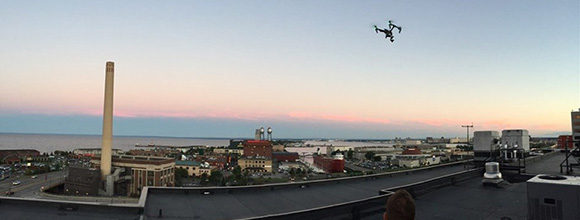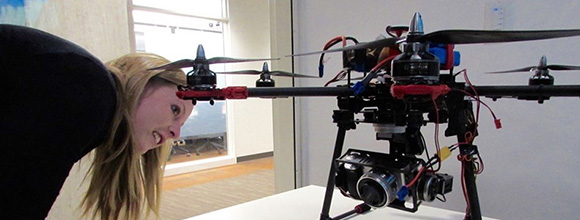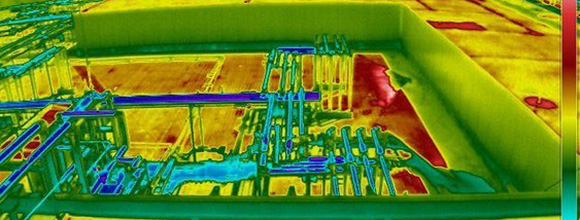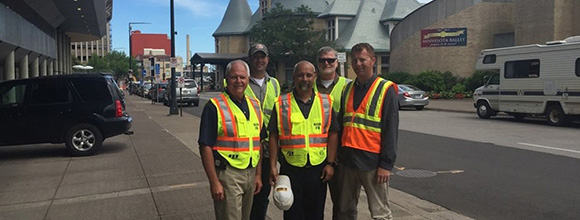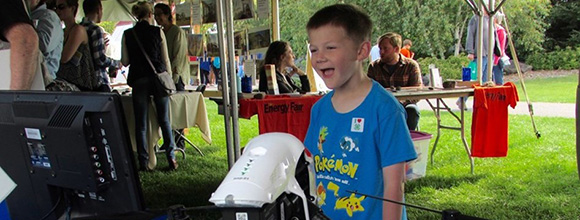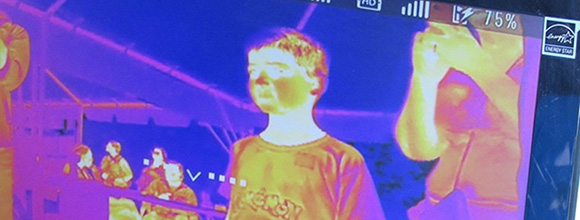Drones could heighten energy savings for MP's commercial customers
Dec 1, 2016
Drones generated a lot of buzz at the Lake Superior Harvest Festival and Energy Fair in September. As folks filed through the energy tent, many could not resist stopping at Minnesota Power’s booth to see a futuristic drone equipped with an infrared camera. As they stepped in front of its lens, their own thermal images appeared on a monitor—graphic displays of heat distribution in brilliant reds, yellows and oranges.
This same technology is being applied to area buildings in a research project funded by Minnesota Power’s Power of One Business Conservation Improvement Program.
The goal is to determine whether drones paired with state-of- the-art thermal imaging equipment can help the utility’s commercial and industrial customers improve the energy efficiency of their facilities.
Drones are taking off at an amazing pace. New federal rules governing their commercial use took effect in August 2016, and the Federal Aviation Administration estimates drone sales for commercial purposes could grow from 600,000 in 2016 to 2.7 million in 2020. The sky is the limit for innovative drone applications. Minnesota Power is ahead of the curve with its study, which started back in 2015.
"We were looking at ways to help customers identify poorly functioning rooftop heating and cooling equipment and refrigerant lines," said Craig Kedrowski, energy efficiency analyst-lead, Minnesota Power. "Inspecting rooftops on foot with a handheld infrared camera is very time consuming and presents safety concerns. Drones were just emerging on the market, so we began to investigate how they might work as a method of delivery—we could find no one else in the country doing this."
Drone specialists
Minnesota Power’s CIP team engaged Micro Aerial Inspection and Mapping (Micro Aerial IM), a Colorado-based company that specializes in using drones for aerial photography, inspection and mapping solutions. In December 2015, Minnesota Power hosted an informational session about drone technology and potential applications in the commercial energy-efficiency field. Facility managers and maintenance personnel from several large Minnesota Power customers gathered at the St. Louis County Government Services Center to hear a presentation by Micro Aerial IM President Craig Gallagher and CIP representatives.
Craig Gallagher shared his knowledge of drones and considerations for their use in various applications. He spoke of the vast amount of data they could collect and rapid advances in sensors and imagery. At the same time, he cautioned the group about challenges for early adopters, including high costs and vague rules governing drone operation.
"People see new technology and want to use it because it is cool, but it might not cover every application," Craig Gallagher said. "Are there other sources for the data you need, and what does it cost compared to using drones to collect that data? These are questions you have to ask."
CIP commercial energy consultant Tanuj Gulati of Energy Insight Inc. presented a list of potential ways drone technology might support Minnesota Power’s commercial energy conservation efforts. They included using drone-mounted imaging equipment to define the external layout or footprint of a building, check HVAC equipment, analyze roof conditions on commercial/industrial buildings, and inspect the building envelope.
"Our goal is to determine whether use of drone-based thermal imaging would maximize energy savings for clients," Gulati told the group. "Could this technology help Minnesota Power customers?"
Initial tests
Early in 2016, Minnesota Power CIP funded preliminary flights at the utility’s corporate headquarters in downtown Duluth and the Duluth Public Library, a building the city of Duluth has identified as having a high potential for energy upgrades. Micro Aerial IM fitted one of its drones with a thermal camera for the exercise.
"We had to create our own wiring harness," Craig Gallagher said. "Being on the forefront of technology sometimes means learning on the fly."
The initial flights were eye opening to all of those involved.
"It was a great visual for the customers and for us to highlight potential savings due to energy loss or gain," said Tim Gallagher, supervisor of program implementation for Minnesota Power. "One drawback was the first camera we used could only identify relative temperature differences, not provide actual temperatures."
In August 2016, the tests were repeated with a more sophisticated drone-mounted thermal camera that measured temperatures in degrees for every pixel in the image rather than simply providing a temperature range.
Additional flights were conducted at food processing and packing plants in central Minnesota, industrial sites with significant refrigeration equipment.
"Rather than just looking at pieces of equipment, we found ourselves looking at the roof itself," Gulati said. "We could see leaks where insulation was not performing as it should, as well as equipment, refrigerant lines and heating and cooling aspects. The drone gave us the capability to capture the whole plant or rooftop in one picture and quickly identify potential trouble spots."
"The data we got last winter was good because we could use it to make assumptions about where potential energy savings existed," Craig Gallagher said. "Now, with the new camera, we have data that may allow us to quantify energy savings."
"The more we do with these infrared cameras on drones, the more we learn," Kedrowski said. "Next, we need to sit down and review what has been done to date, analyze the costs and benefits, and determine our next steps. It sure looks like there is potential, but it is a very developing process.
For information about how you or your business can save energy, click here.

